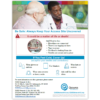
Vascular Access
The Centers for Medicare & Medicaid Services (CMS) continues to focus on long-term catheter rates and solutions for mitigation of the use of central venous catheters in patients who have the option for a more optimal access, such as Arteriovenous Fistula, Arteriovenous Graft, or Peritoneal Dialysis Catheter. This page is dedicated to helping dialysis providers work toward the CMS goal of decreasing long-term catheters by placing and maintaining vascular access in those patients who have selected hemodialysis as their choice of modality. Vascular Access Management is quite complicated and includes many layers of targeted intervention to make improvements. You will find resources on this page to assist clinics in management of vascular access and to help patients choose and maintain the best access for each individual circumstance.
Resources

Download: Tips for a Healthy Body Image During Dialysis

Download: Tips to Ease Needle Fear

Download: My Choices Self Cannulation

Download: Be Safe: Keep Your Access Site Uncovered

Download: TLC for Your Access

Download: My Choices: What I Should Know About Fistulas
Lifeline for a Lifetime “One-Minute Access Check”
The FF/CL Access Monitoring Workgroup through the ESRD Network Coordinating Center has developed an interactive tool that will help you learn how to perform a quick access check and what to watch for to determine if there is a problem with a patient’s access.
You can access the steps and tools for the “one minute access check”. The process map and tools support the five components for the one minute access check that can be performed daily by the patients, the dialysis staff at each dialysis treatment and expert clinicians when problems are identified.
ANNA Save the Vein Project
This program focuses on the importance of vein preservation in chronic kidney disease (CKD) patients. It features silicone wristbands that reads “SAVE VEINS – NO IV/LAB DRAWS” for patients to wear to minimize the vascular trauma prior to placement of a fistula. A patient education brochure is also available to help educate about the importance of vein preservation.
Helpful Websites & Other Resources
- Vascular Access Management
- Renal Physicians Association
- NKF KDOQI Guidelines
- Fistula or Catheter: A Patient Perspective
- National Forum of ESRD Networks
- National Forum Catheter Reduction Toolkit
- Institute for Healthcare Improvement
